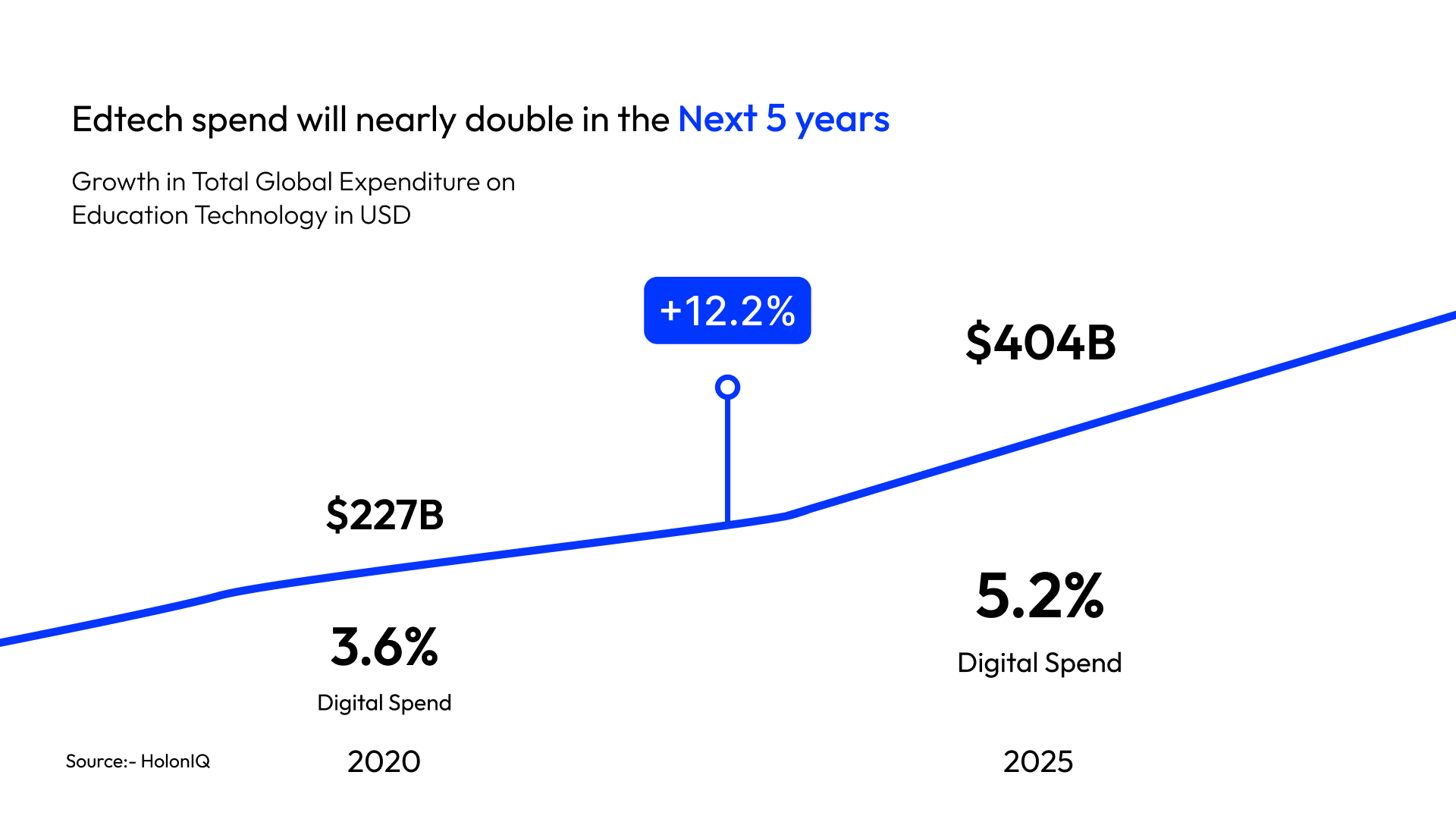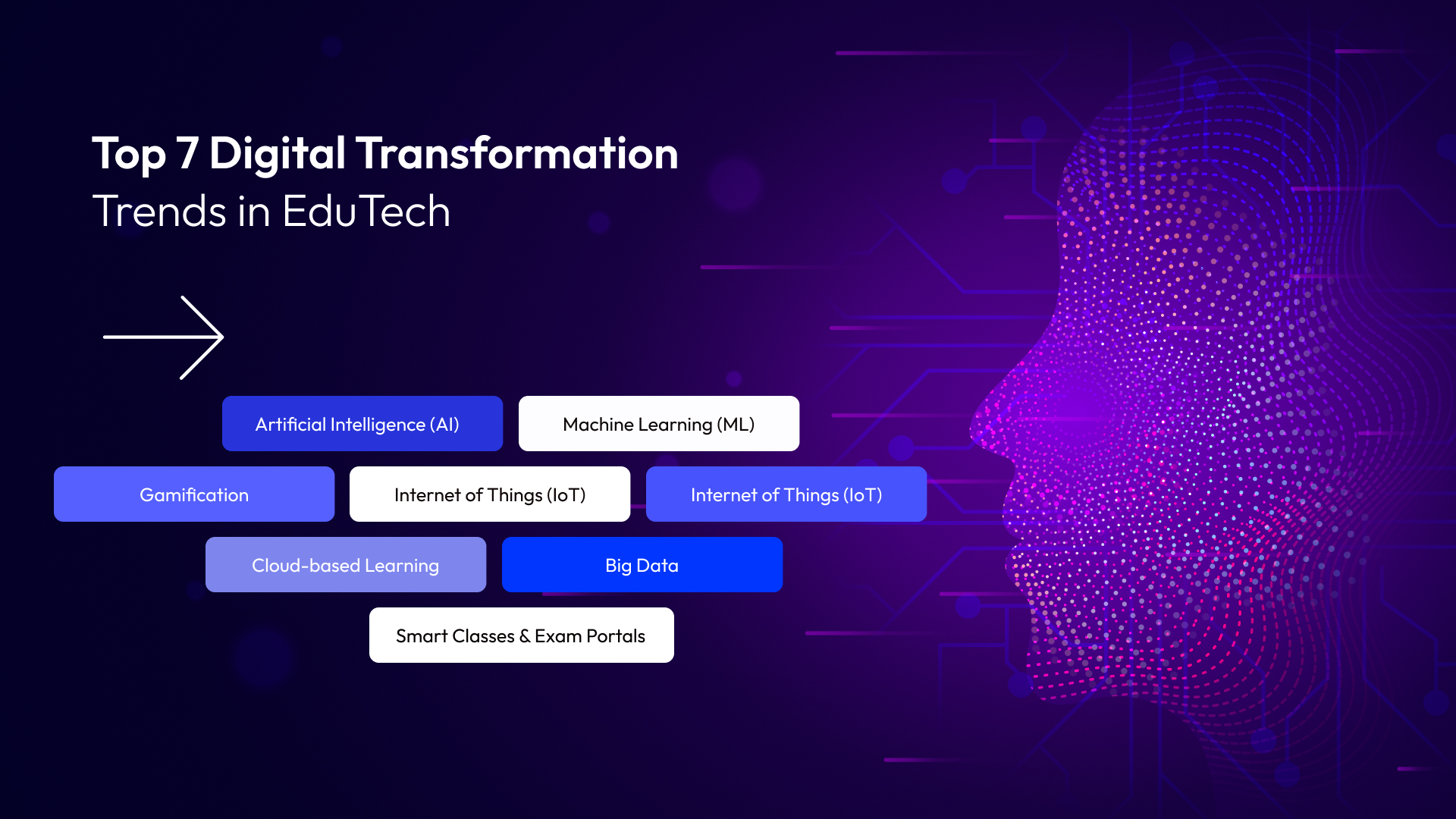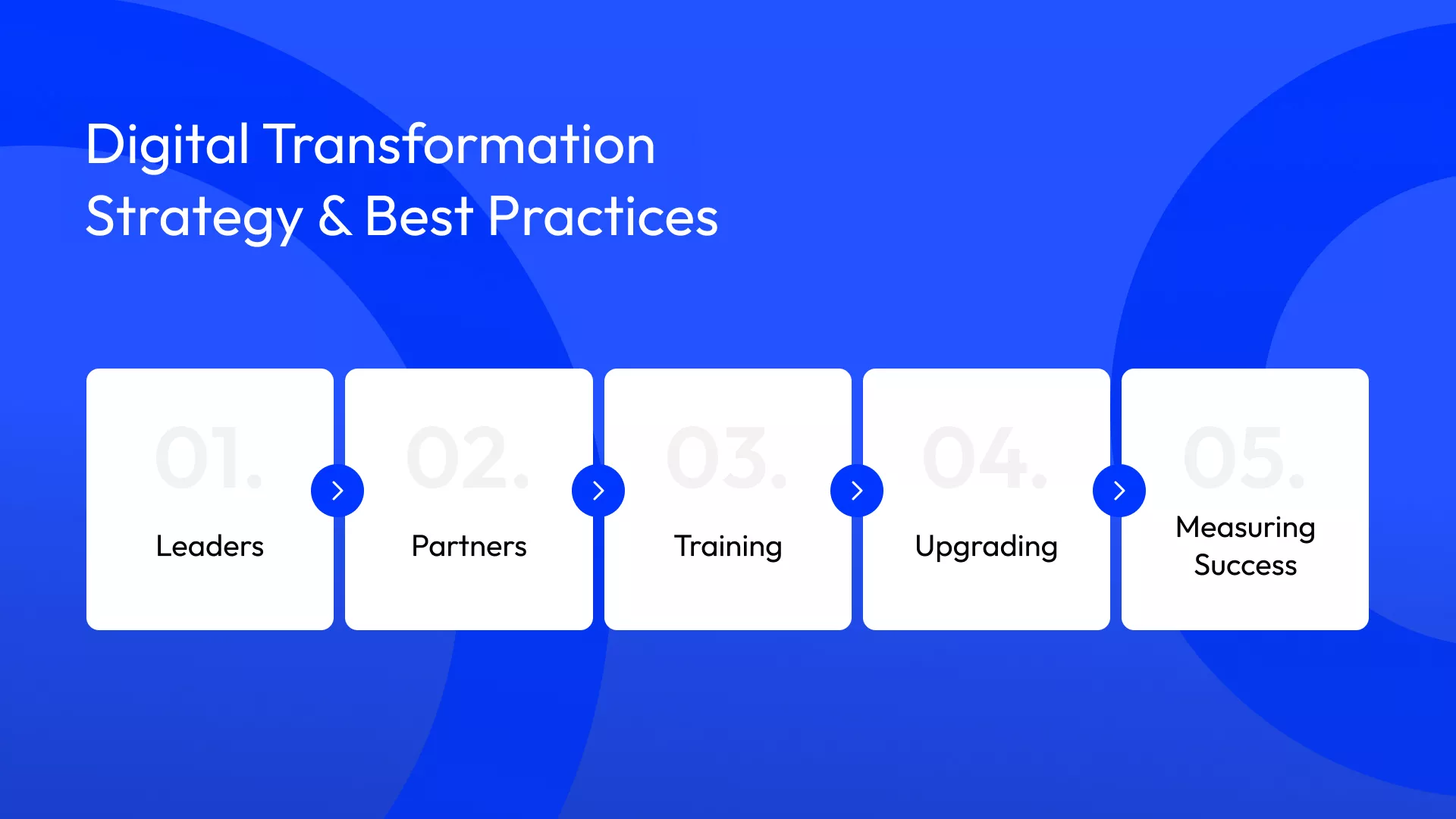Composable Enterprise Applications: The Future of Scalable Business Architecture
Transforming EduTech: Digital Trends & Strategies
The technology revolution has impacted nearly every aspect of our lives. The widespread access to smartphones and the internet has influenced how billions connect, interact, and perceive the world around them. The digital shift also brought a profound transformation in the education sector, enhancing the learning and teaching experiences.
The Covid-19 pandemic accelerated the trend as schools, colleges, and universities were forced to close. Teachers and students turned to technology to bridge the communication gap, ensuring a continuous learning process. Online learning is one of the critical aspects of how EduTech has brought a fundamental change in classroom trends. Explore how digital transformation impacts the education systems with emerging technology trends, digital tools, and strategies.
What is Digital Transformation in the Education sector?
Digital transformation in education is the process of leveraging digital technologies to enhance the learning and teaching experiences. EduTech involves digitizing administrative and learning processes while simplifying the workloads of mentors, alumni, and school management. It focuses on:
- Quick and seamless student enrollment in educational organizations like schools, colleges, and universities.
- Interactive and personalized digital learning experiences.
- Better tracking of students’ attendance, progress, and performance.
- Improve accessibility to education through virtual classrooms, allowing students to learn from anywhere on any device.
The process involves rewiring structures and academic models to create a more technology-driven education system. Educational innovation is an opportunity to address challenges students face, such as struggling to stay engaged in a world increasingly dominated by the digital world. By utilizing new approaches and tools, educational institutions can improve the quality of learning outcomes and make education more accessible to a broader range of learners.
Why is Integrating Digital Technologies in Education Necessary?
Education accounts for more than 6% of the world’s GDP and is one of the leading industries driving economic growth. The total global spending on education and learning by the government, educational businesses, and customers is anticipated to reach $7.3T by 2025. Spending on Edtech is forecasted to grow from $227B in 2020 to $404B by 2025, with an upswing in expenditures on digital tools, infrastructure, and automated systems.

Digital transformation in education occurs on three levels - individuals, educational community, and regions. Modernization of traditional classrooms and the upgradation of existing educational and administrative methods facilitate an uninterrupted transfer of knowledge, enable adaptability, and ensure constant connection across various points in the education system.
Digital transformation in higher education introduces various learning approaches that encourage active participation and allow students to interact directly with course materials and assignments. Features like text-to-speech functionality remove obstacles to learning, ensuring that education is more inclusive and available to all learners regardless of their physical abilities.
Critical Areas of Technology Transformation in Education
Education institutes have gained a lot through digital transformation, whether by enhancing students' learning journeys or automating repetitive administrative processes. Discover the critical areas where digitization has brought higher impact, simplifying the digital learning and administrative process.
Admission Process
Schools and universities can eliminate the time-consuming student enrollment by using a unified digital education system. This system helps students and school administrators avoid the hassle of tedious paperwork. Students no longer need to stand in long queues to submit and check their application status. Applying and enrolling are done online without visiting the campus.
Student Management
The introduction of technology in education has made managing students’ documents, attendance, and class schedules easy. It improves productivity, simplifies student management, and reduces the chances of human errors. Digital transformation has shifted the focus of teachers, counselors, and administrators from repetitive, mundane tasks to core job functions. As a result, they can allot more time to each student and help them learn faster.
Infrastructure Modernization
Outdated infrastructure in educational institutions is one of the reasons that educators and students struggle for seamless interactivity and real-time information exchange. Modernization and digital transformation efforts in education improve operational efficiency and knowledge delivery without disruption. The introduction of live coaching through virtual classrooms, self-paced courses, and hybrid EdTech models has resulted in a surge in the student retention rate.
Performance Evaluation
Digitization has many benefits for students, including faster access to study materials, tests, and grades for self-performance evaluation. Online learning or eLearning systems allow learners to attend tests online, submit papers, check instant scores, and track attendance. Evaluating performance and finding ways to improve it has become easy for them through digital platforms as the results are measurable.
Top 7 Digital Transformation Trends in EduTech
Mapping out the areas of the technology modernization roadmap is necessary to ensure a successful digital transformation. The key technology trends and tools enabling digital transformation in education include:
Artificial Intelligence (AI)
Personalized learning has been the most critical aspect of the EdTech revolution, and AI plays a significant role in accomplishing it. Instead of fitting every student into the same box, schools and colleges have realized the value of providing customized lessons and courses to students based on their capabilities, strengths, and weaknesses.
Educational institutions use AI to analyze students' skill levels and progress and curate personalized learning programs and automated curricula. AI-enabled assessments highlight topics that need attention and help students improve their performance scores, reducing the risk of failures.
Machine Learning (ML)
Machine learning leverages algorithms to enable machines to learn from data patterns resembling human-like intelligence. The education sector employs ML to address numerous issues, from automating repetitive administrative processes to accurately assessing student performance.
ML algorithms combined with advanced predictive analytics assist educators and administrators through study guides, forecast enrollment numbers, identification of students at risk of expulsion, and many more. Adopting ML frees up valuable time for the teaching staff, which can be dedicated to enhancing the student's learning process.
Gamification
Interactive learning is the fundamental base for digital transformation in education to boost student engagement. Gamification helps achieve this by integrating fun gaming elements into the online learning modules. Online games and quizzes strengthen the cognitive abilities of the learners.
Through interactive games, they can acquire problem-solving skills and valuable knowledge. Although gamification is centered around entertainment, it encourages students to engage with others, set and achieve goals, and gain instant feedback on correcting mistakes. It provides all-around skill development for learners.
Internet of Things (IoT)
Incorporating the IoT into the school environment in the age of “smart devices” helps students and educators connect in a completely new way. IoT holds the potential to transform both learning and teaching experiences. Education campuses can improve security, track attendance, and enable real-time communication. The increased use of smartphones enhances the connectivity between educational organizations and parents, alerting them to security.
Cloud-based Learning
The cloud provides students access to knowledge from anywhere, anytime. The pandemic accelerated the adoption of cloud applications, prompting schools and colleges to move their courses and operations online. The cloud platforms enabled them to host lectures, post videos, and conduct examinations for students. Cloud-based remote learning helps the learners keep pace with the course without meeting their teachers in person. They can even submit assignments, track syllabus, and evaluate progress.
Big Data
The cloud provides students access to knowledge from anywhere, anytime. The pandemic accelerated the adoption of cloud applications, prompting schools and colleges to move their courses and operations online. The cloud platforms enabled them to host lectures, post videos, and conduct examinations for students. Cloud-based remote learning helps the learners keep pace with the course without meeting their teachers in person. They can even submit assignments, track syllabus, and evaluate progress.
Smart Classes & Exam Portals
The concept of smart classes involves incorporating student engagement techniques through interactive content. Unlike blackboard learning in traditional classrooms, digital technology enables students to learn by watching videos or media content. Smart boards, steady internet connectivity, computers, video conferencing tools, and projectors make knowledge and study materials available and accessible in real time, enhancing the students' learning outcomes. Conducting assessments is no longer a challenge for schools, colleges, and universities. Integrating webcams into online exam portals ensures a smooth and fair examination process by monitoring students' activities during the exam.

Use Cases for Digital Transformation in Education
The digital transformation wave has been successful in empowering learners, educators, and administrators across a large number of educational institutions. Adopting a holistic approach and selecting the right technology has resulted in the development of the following user-friendly and successful digital systems.
Arizona State University
Arizona State University has integrated Amazon Echo Dot devices across its campus and student housing to serve as voice-activated information hubs. These smart speakers offer students, faculty, staff, and alumni quick access to university-related information through simple voice commands. The initiative aims to enhance the campus experience by providing a convenient way to access important details about ASU services, events, and resources.
Google Expedition
Google Expedition is an educational app featuring 1000 virtual reality and 100 augmented reality tours. The app allowed teachers and students to explore diverse environments virtually, from art galleries and museums to underwater scenes and outer space. Google is now transferring these immersive tours to its Google Arts & Culture platform, making them accessible to a broader audience beyond the classroom setting.
Carnegie Learning
It is a leading service provider of K-12 education technology, offering innovative learning solutions and curriculum for K-12 schools. Their flagship product, MATHia, is an AI-powered math learning platform that provides personalized tutoring for each student. The system continuously adapts to individual learning patterns, providing tailored instruction and practice problems to optimize comprehension and skill development in mathematics.
Challenges in EduTech Transformation
A digital transformation is a journey of change that inevitably encounters obstacles along the way. As the education industry ventures on its transformative path, addressing and acknowledging the potential challenges is crucial. The key challenges in integrating technology for digital transformation in education are:
Digital Divide: Socioeconomic disparities and lack of steady internet connectivity create a digital divide, limiting access to opportunities and worsening educational disparities.
Lack of digital literacy: A lack of proper digital skills and literacy among teachers and students in effectively utilizing digital tools in teaching and learning further deepens the skill gap.
Limited resources: Resource allocation and financial investment constraints sometimes hinder the proper implementation of digital transformation approaches in many schools or colleges.
Lack of awareness: According to a McKinsey survey on leveraging technology to shape learning, limited familiarity among educators and learners is one of the key reasons for the lower adoption rate of online learning tools in higher education institutions.
Data Security & Protection: Technological adoption in education brings inherent risks. To mitigate these, organizations must implement robust cyber security measures and clear technology usage policies, safeguarding student data and encouraging a secure, responsible learning environment.
Digital Transformation Strategy & Best Practices
Navigating the path to a digital transformation in education remains a serious concern for educational institutions. Five components define how far you can go, how well you can do, and what you can achieve - leaders, partners, training, upgrading, and measuring success.
Leaders
Digital transformation in education and other sectors relies on leaders guiding them to the digital world. They help organizations set transformative goals, distribute roles, and select digital tools to integrate into the existing infrastructure.
Partners
Choosing the right partner with years of expertise in the educational domain ensures the successful delivery of digital solutions that align with your goals and values.
Training
Digital leaders or partners with whom you collaborate should be able to train your staff on using digital tools. While some educators can be tech-savvy, others might need to upgrade their skills to get familiar with educational technologies and adapt to online teaching courses.
Upgrading
Digitization in education is an approach that empowers academic organizations to upgrade their existing systems and also integrate new ones consistently. Adopting new digital educational models and letting go of outdated and ineffective methods enables an institution to transform successfully.
Measuring Success
Assessing student engagement, digital adoption rate, and educators' satisfaction with digital tools is critical to measuring success. These evaluations help understand technology's impact and plan new strategies for integrating tech solutions into the system.

Digital Education: A New Horizon in the Future
As digital adoption in education continues to evolve, technological innovation and trends are redefining students' overall learning experience and educators' teaching experience. The future of education focuses heavily on socio-emotional learning, gamification, and microlearning.
The growing adoption of digital learning models and platforms will provide more accessibility, flexibility, and learning opportunities. Combining traditional classroom learning with online systems is also expected in the future, facilitating collaborative learning. Integrating trending technologies such as AI, ML, AR/VR, data analytics, and cloud transforms teaching with personalized learning, visualization of complex concepts, and easy identification of students' strengths and weaknesses. Technology transformation enables teachers to provide students with an engaging and immersive online learning experience, preparing them for the future.
The Bottom Line: Thriving in the Digital World
The significance of digital transformation in education was underestimated until the Covid-19 pandemic. Since 2020, educational organizations have prioritized technology adoption and digitalization of education processes. The shift towards a tech-driven modern education system has a measurable impact on students' progress, increasing their willingness to learn.
It also simplifies administrative operations, enhancing accuracy and efficiency. EduTech transformation is inevitable and will soon involve every institution worldwide. It would enable broader and inclusive opportunities, distance learning, better teaching experiences, and enhanced student engagement.
Email us or Talk to us at +91-98367-81929 or Simply Contact Us through the website.
Let's Connect








